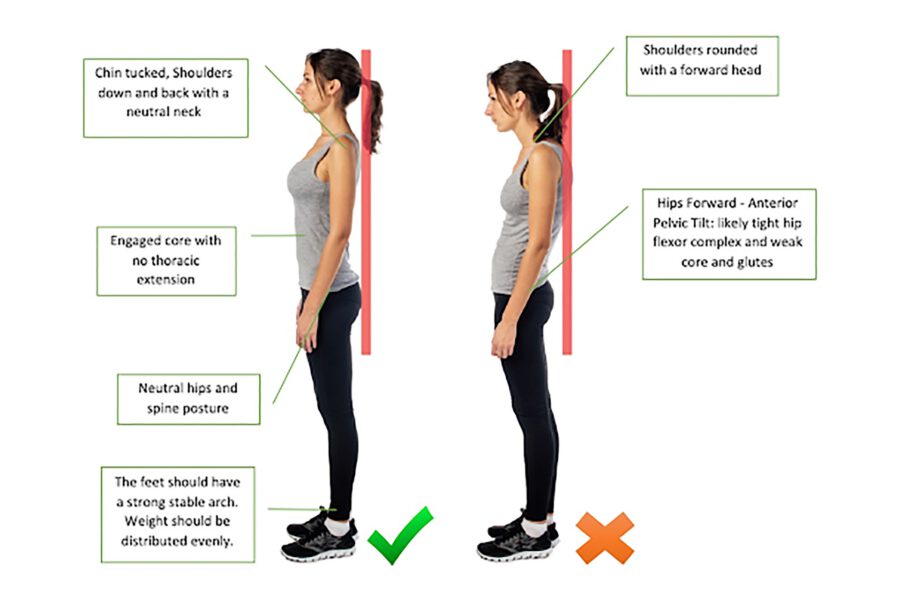Posture Fix: 15-Minute Exercise for Healthy Alignment
Your posture is the foundation of every motion your body performs and influences how effectively you adjust to various physical demands and challenges. Simply put: better posture equals better movements and health.
However, modern lifestyle factors, such as sedentary work environments, increased screen time, and lack of physical activity, predispose you to develop poor posture habits, muscle imbalances, and other health issues.
This article will discuss the science of posture and different exercises to improve posture and promote healthy spinal Alignment.
Your posture is an automatic and unconscious position that reflects your body’s response to gravity. Thanks to the strength and coordination of your muscles, you are able to stand and sit upright, counteracting gravity without slumping or collapsing.
However, weakness, tightness, injuries, and muscle imbalance can result in bad posture and intensify the pull of gravity on the body. You can see these in people with overly tight chests and weak back muscles.
In addition, the human body is highly adaptable. It adjusts to the positions that we frequently adopt. For example, if you spend many hours sitting daily, your body becomes efficient in sitting, turning off the back muscles and hyperactivating the hip flexors and neck muscles.
So what is the correct posture?
A proper posture involves maintaining the natural curves of the spine, which include the cervical curve (neck), thoracic curve (upper back), and lumbar curve (lower back).
This posture helps evenly distribute the force of gravity throughout the body, which reduces stress on the muscles and joints.
If your posture is not optimal, your muscles must work harder to maintain balance and keep you upright. Unfortunately, this can lead to some muscles becoming tight and inflexible or, worst, inhibited.
Over time, these maladaptive changes hinder your body’s ability to cope with various stresses, such as gravity and physically demanding tasks. In addition, poor posture contributes to wear and tear of the joints, increases the risk of injuries, and can lead to scoliosis, tension headaches, and other health issues.
Studies have shown that posture influences your emotional state and pain sensitivity. For example, people with poor posture are more likely to be anxious and stressed and have low self-esteem. Even worse, others tend to have negative impressions of people with bad postures, affecting social interactions and personal relationships.
Aside from reducing pain and discomfort, maintaining proper posture has numerous benefits that positively impact your overall well-being. Some of the key benefits are:
An optimal posture allows your lungs to expand fully, enabling more oxygen intake and efficient breathing patterns. This allows you to do more and last longer when performing strenuous activities, enhancing your energy levels.
Good posture can contribute to increased focus, alertness, and productivity by promoting proper oxygenation in the brain and reducing physical discomfort.
Maintaining an upright posture promotes better blood flow, ensuring your organs receive adequate oxygen and nutrients for optimal functioning and recovery.
Proper posture engages the core muscles, which support and stabilize the spine. Strong core muscles are essential for balance and steadiness. In fact, most sports depend on the stability of the core muscles.
A balanced upright posture can make you appear taller, more confident, and more assertive. Combined with your gains in the gym, this will further boost your physique and overall appearance.
Your physical activities and movement pattern dictates your posture. Therefore, to correct bad posture, you must counter it with exercise and corrective movements. An excellent solution is to include postural exercises in your movement snacks and a regular fitness routine.
Here are the best exercises that target the muscles responsible for maintaining proper Alignment and help undo the harmful effects of poor habits and sedentary lifestyles:
This position stretches all the tight and hyperactive muscles associated with prolonged sitting and sedentary lifestyles.
How to do it:
- Lie on your stomach. Position your hands beneath your shoulders
- Press through your hands and lift your chest off the ground
- Keep your hips and lower body in contact with the floor
- Hold this position for 20-30 seconds
- Repeat for 3 sets
This exercise helps strengthen the neck muscles and counteracts forward head posture.
How to do it:
- Stand or sit up straight
- Gently tuck your chin towards your chest, creating a “double chin”
- Hold for 6 to 10 seconds.
- Relax
- Repeat for 10 to 15 times
Here’s training program that uses kettlebells, which is a great way to improve your posture:
This exercise helps strengthen the upper back and improve shoulder mobility.
How to do it:
- Stand with your back against a wall
- Flatten your lower back against the wall by engaging your core
- Ben your elbows at a 90-degree angle and press them against the wall
- Gently slide your arms up and down the wall, maintaining contact with the wall
- Do this for 10 to 15 reps
This exercise helps increase thoracic spine mobility and counteracts a hunched posture.
How to do it:
- Sit on a chair
- Place your hands behind your head. Position your elbows pointing out to the sides
- Gently arch your upper back (thoracic spine) while keeping your lower back stable
- Hold for 6 to 10 seconds, then return to the starting position
- Repeat 10-15 times
This stretch helps alleviate tight hip flexors from prolonged sitting and
How to do it:
- Begin in a lunge position. Position your right foot forward and your left knee on the ground
- Engage your core and tuck your tailbone under, creating a posterior pelvic tilt
- Gently lean forward, feeling a stretch in the front of your left hip
- Hold for 20-30 seconds, then switch sides
- Do this for 3 sets for each side
This exercise helps correct tightness and asymmetries on one side of the body, allowing you to achieve a more even posture.
How to do it:
- Stand up straight. Position your feet hip-width apart
- Keep your shoulder relaxed and chest out
- Place one hand on your hip to stabilize your body
- With the other hand, extend your arm up and slightly back behind your body at a diagonal angle.
- As you reach up, gently shift your weight onto the opposite side
- Focus on reaching towards the ceiling, feeling a stretch along the side of your torso and ribs
- Hold for 6 to 10 seconds
- Relax and repeat on the opposite side
- Repeat 5 times on each side
This exercise helps increase upper back and lower back mobility. It also works well in alleviating back pain due to muscle tightness and fatigue.
How to do it:
- Begin on all fours
- Inhale and arch your back, lifting your chest and tailbone toward the ceiling (Cow Pose)
- Exhale and round your back, tucking your tailbone and bringing your chin to your chest (Cat Pose)
- Perform 10-15 repetitions, moving smoothly between the two poses.
This exercise is designed to release tightness and tension in the butt muscles and increase hip flexibility and mobility.
How to do it:
- Lie on your back. Bend both of your knees.
- Put your right ankle on your left thigh near your knee
- Use your hands to pull your knees toward your chest gently
- Hold for 20 to 30 seconds
- Repeat 5 times on each side
Modern lifestyle doesn’t promote much movement. Sitting all day and too much screen time contributes to developing bad posture, which can negatively affect your health. By incorporating a 15-minute daily routine of postural exercises, you can minimize muscle imbalance and promote healthy postural Alignment.


